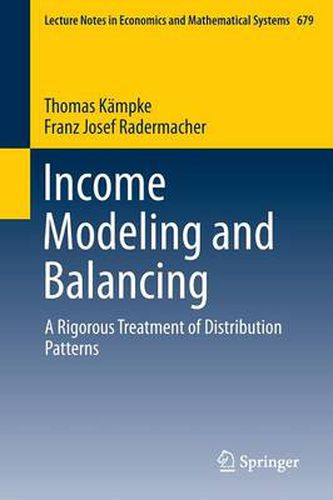Readings Newsletter
Become a Readings Member to make your shopping experience even easier.
Sign in or sign up for free!
You’re not far away from qualifying for FREE standard shipping within Australia
You’ve qualified for FREE standard shipping within Australia
The cart is loading…






This title is printed to order. This book may have been self-published. If so, we cannot guarantee the quality of the content. In the main most books will have gone through the editing process however some may not. We therefore suggest that you be aware of this before ordering this book. If in doubt check either the author or publisher’s details as we are unable to accept any returns unless they are faulty. Please contact us if you have any questions.
This book presents a rigorous treatment of the mathematical instruments available for dealing with income distributions, in particular Lorenz curves and related methods. The methods examined allow us to analyze, compare and modify such distributions from an economic and social perspective. Though balanced income distributions are key to peaceful coexistence within and between nations, it is often difficult to identify the right kind of balance needed, because there is an interesting interaction with innovation and economic growth. The issue of justice, as discussed in Thomas Piketty’s bestseller Capital in the Twenty-First Century or in the important book The Price of Inequality by Nobel laureate Joseph Stiglitz, is also touched on. Further, there is a close connection to the issue of democracy in the context of globalization. One highlight of the book is its rigorous treatment of the so-called Atkinson theorem and some extensions, which help to explain under which type of societal utility functions nations tend to operate either in the direction of more balance or less balance. Finally, there are some completely new insights into changing the balance pattern of societies and the kind of coalitions between richer and poorer parts of society to organize political support in democracies in either case.
Oxford University’s Sir Tony Atkinson, well known for his so-called Atkinson theorem, writes in his foreword to the book: [The authors] contribute directly to t
he recent debates that are going on in politics. […] with this book the foundation of arguments concerning a proper balance in income distribution in the sense of identifying an ‘efficient inequality range’ has got an additional push from mathematics, which I appreciate very much.
$9.00 standard shipping within Australia
FREE standard shipping within Australia for orders over $100.00
Express & International shipping calculated at checkout
This title is printed to order. This book may have been self-published. If so, we cannot guarantee the quality of the content. In the main most books will have gone through the editing process however some may not. We therefore suggest that you be aware of this before ordering this book. If in doubt check either the author or publisher’s details as we are unable to accept any returns unless they are faulty. Please contact us if you have any questions.
This book presents a rigorous treatment of the mathematical instruments available for dealing with income distributions, in particular Lorenz curves and related methods. The methods examined allow us to analyze, compare and modify such distributions from an economic and social perspective. Though balanced income distributions are key to peaceful coexistence within and between nations, it is often difficult to identify the right kind of balance needed, because there is an interesting interaction with innovation and economic growth. The issue of justice, as discussed in Thomas Piketty’s bestseller Capital in the Twenty-First Century or in the important book The Price of Inequality by Nobel laureate Joseph Stiglitz, is also touched on. Further, there is a close connection to the issue of democracy in the context of globalization. One highlight of the book is its rigorous treatment of the so-called Atkinson theorem and some extensions, which help to explain under which type of societal utility functions nations tend to operate either in the direction of more balance or less balance. Finally, there are some completely new insights into changing the balance pattern of societies and the kind of coalitions between richer and poorer parts of society to organize political support in democracies in either case.
Oxford University’s Sir Tony Atkinson, well known for his so-called Atkinson theorem, writes in his foreword to the book: [The authors] contribute directly to t
he recent debates that are going on in politics. […] with this book the foundation of arguments concerning a proper balance in income distribution in the sense of identifying an ‘efficient inequality range’ has got an additional push from mathematics, which I appreciate very much.